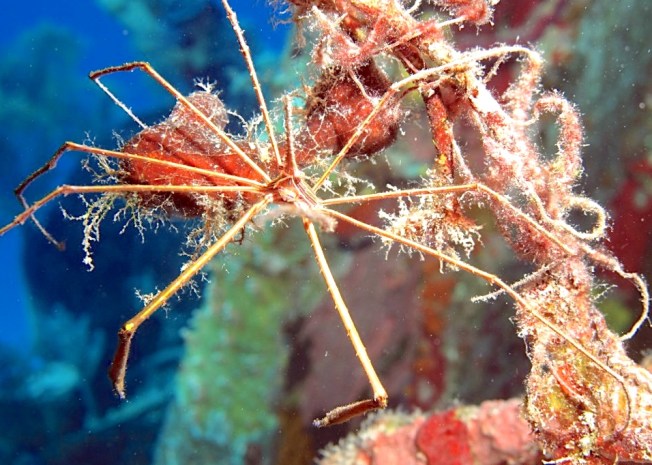WTF? (WHAT’S THAT FISH?) 14: ARROW CRABS
It’s been a while since the last in the WTF? series, which is dedicated to the wilder, less conventionally fish-shaped side of reef life – those creatures that you may come across, blink into your face-mask, and silently mouth the words ‘What’s That Fish?’ (that’s what it looks like you are saying, anyway).
Let’s meet some Arrow Crabs Stenorhynchus seticornis, one of the very few creatures surely to have a triangular body plus a huge pointy nose (rostrum), supported on long skinny legs. To which add, they wear tiny blue gloves on their two front claws.
These crabs are coral reef dwellers and mostly stay concealed during the day. Their body is protected by a carapace, and the rostrum has serrated edges like a tiny rasp or file. I haven’t found a definitive reason for this gadget, but I suspect it is more for probing than for piercing or fighting.
There’s a considerable colour variation among these crabs, as these images show. The body may even have blue iridescent lines (#2, above). And those claws may be any of 50 shades of blue…
Arrow crabs are most active at night. They eat feather-duster worms (illus.) and similar invertebrates such as bristle worms.
Like certain types of shrimp, they also have a symbiotic relationship with anemones, whereby they make use of an anemone to benefit from the food it captures – and possibly for cover too. They are protected from anemone stings, whereas some of their predators are not.
This was the place where I was going to tell you about the arrow crab’s private life, but, well… “it’s complicated”. Briefly it is: male passes sperm-filled capsule to female; she uses it in some way whereby it fertilises her eggs; she then ‘broods’ the eggs in one of her ‘swimming legs’; the eggs hatch into larvae and swim off to eat plankton; each one then grows & moults, repeating the process until it has reached adult form. On balance, humans have arguably perfected a preferable method.
Arrow Crabs are apparently popular aquarium creatures, although they sound to me rather a disagreeable challenge. They can move quickly on those long legs, and it seems as if they inclined to be aggressive to other inhabitants of the tank. As far as I can make out, it’s best not to put 2 of them together: they certainly won’t be doing the sperm capsule thing described earlier…
Photo credits: Melinda Riger / G B Scuba (1, 3, 4, 5, 6); Adam Rees / Scuba Works (2, 8, 9); Nick Hopgood,Wiki (7); Chuck Elliot – video










What an extraordinary creature! And slightly spidery-creepy!
LikeLike
Quite agree, Lucy. Not one I chose for an aquarium. Nor to share a bath with… RH
LikeLike
Hello as someone who has recently joined I enjoy all the info you provide especially on the birds . Sitting here at Long Beach just down the road from you its wonderful to get the info especially when I can sit on my own deck and check out all the birds that frequent my property and that you speak of . Again thanks I purchased the bird book a few years ago and enjoy it . My wife & I have finally made our dream come true and stay down here from Nov to April rather than frozen Canada . Regards Keith Parsons
On Tue, Jan 16, 2018 at 1:47 PM, ROLLING HARBOUR ABACO wrote:
> Rolling Harbour posted: ” WTF? (WHAT’S THAT FISH?) 14: ARROW CRABS It’s > been a while since the last in the WTF? series, which is dedicated to the > wilder, less conventionally fish-shaped side of reef life – those creatures > that you may come across, blink into your face-mask, an” >
LikeLike
Hi Keith, thanks so much for your kind comments! And I’m so pleased you enjoy the book. Long Beach is the #1 spot for the rare piping plovers that overwinter on Abaco. I run Abaco Piping Plover Watch online – if you happen to see any tiny shorebirds wearing pink bands (= banded on Long Beach as part of a research project), let me know!!!!
I’m so pleased you have found somewhere congenial to escape from the frozen north. I guess you have the best of both worlds now. Best, RH
LikeLike